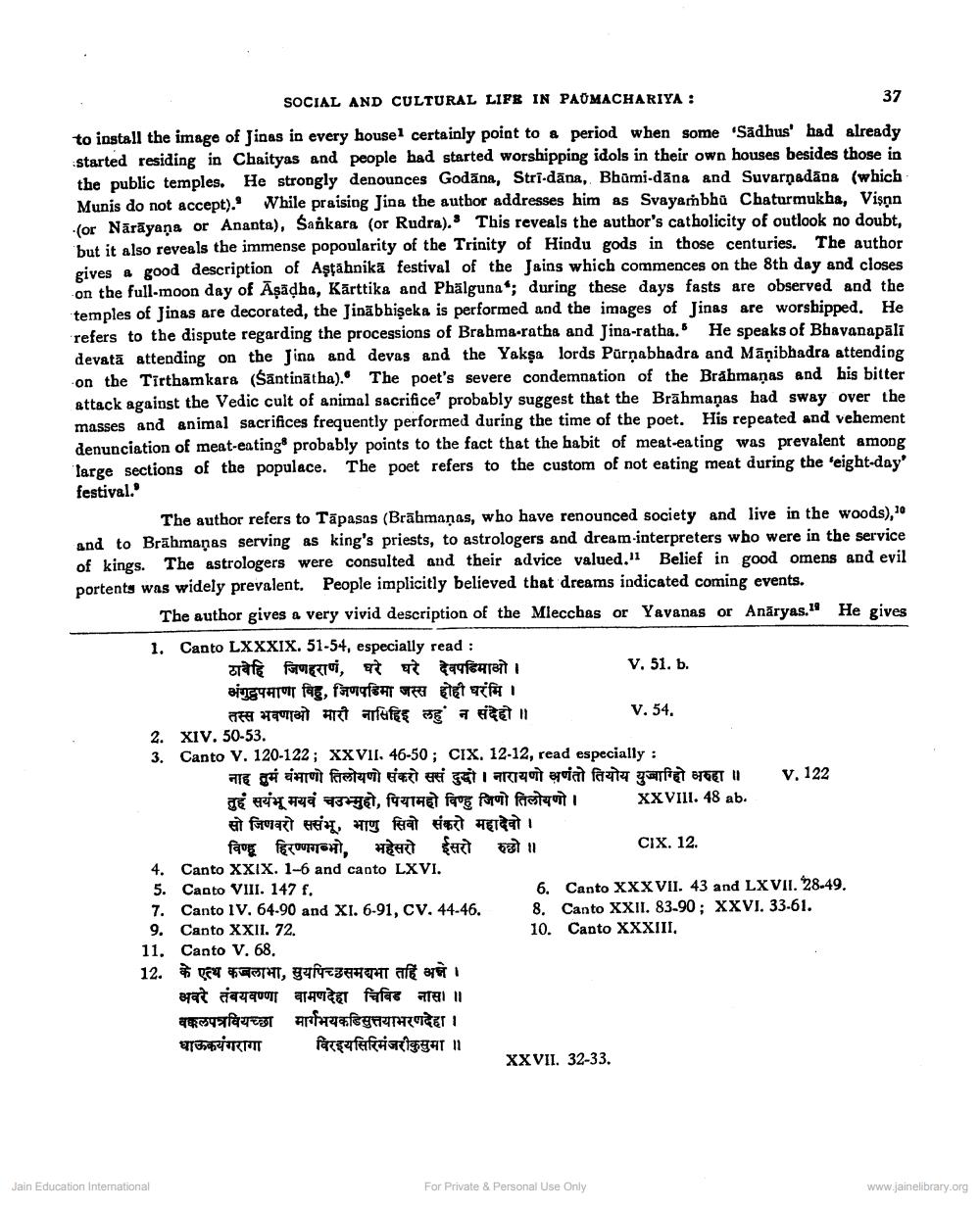________________
while praising lip Rende. This revealede gods in
SOCIAL AND CULTURAL LIFE IN PAOMACHARIYA :
37 to install the image of Jinas in every housel certainly point to & period when some "Sädhus' had already started residing in Chaityas and people had started worshipping idols in their own houses besides those in the public temples. He strongly denounces Godāna, Stri-dāna, Bhami-dana and Suvarnadāns (which Munis do not accept). While praising Jina the author addresses him as Svayambhu Chaturmukha, Vişnn (or Narayana or Ananta), Sankara (or Rudra).This reveals the author's catholicity of outlook no doubt. but it also reveals the immense popoularity of the Trinity of Hindu gods in those centuries. The author gives a good description of Aştahnikā festival of the Jains which commences on the 8th day and closes on the full-moon day of Āsādha, Kārttika and Phälguna*; during these days fasts are observed and the temples of Jinas are decorated, the Jinābhişeka is performed and the images of Jinas are worshipped. He refers to the dispute regarding the processions of Brahma-ratha and Jina-ratha. He speaks of Bhavanapālī devată attending on the fing and devas and the Yakşa lords Pārņabhadra and Māņibhadra attending on the Tirthamkara (Santinātha). The poet's severe condemnation of the Brahmaņas and his bitter attack against the Vedic cult of animal sacrifice' probably suggest that the Brāhmaṇas had sway over the masses and animal sacrifices frequently performed during the time of the poet. His repeated and vehement denunciation of meat-eating probably points to the fact that the babit of meat-eating was prevalent among farge sections of the populace. The poet refers to the custom of not eating meat during the reight-day' festival.'
The author refers to Tāpasas (Brāhmaṇas, who have renounced society and live in the woods), se and to Brāhmaṇas serving as king's priests, to astrologers and dream-interpreters who were in the service of kings. The astrologers were consulted and their advice valued. "I Belief in good omens and evil portents was widely prevalent. People implicitly believed that dreams indicated coming events.
The author gives a very vivid description of the Mlecchas or Yavanas or Anāryas. He gives 1. Canto LXXXIX. 51-54, especially read : ठावेहि जिणहराणं, घरे घरे देवपडिमाओ।
V. 51. b. अंगुद्वपमाणा विहु, जिणपडिमा जस्स होही घरंमि । तस्स भवणाओ मारी नासिहिइ लहुं न संदेहो ॥
V. 54. 2. XIV. 50-53. 3. Canto V. 120-122 ; XXVII. 46-50; CIX, 12-12, read especially :
HTC Di daruit ferestaut ET E F IARTZateriat fazta yariat BraET v. 122 तुहं सयंभू मयवं चउभ्मुहो, पियामहो विण्हु जिणो तिलोयणो। XXVIII. 48 ab. सो जिणवरो ससंभू, भाणु सिवो संकरो महादेवो । विण्हू हिरण्णगन्भो, भहेसरो ईसरो रुछो॥
CIX. 12. 4. Canto XXIX. 1-6 and canto LXVI. 5. Canto VIII. 147 f.
6. Canto XXXVII. 43 and LXVII. 28.49. 7. Canto IV. 64.90 and XI. 6-91, CV. 44-46. 8. Canto XXII. 83-90; XXVI. 33-61. 9. Canto XXII. 72.
10. Canto XXXIII, 11. Canto V. 68. 12. $ EU THT, 941 af 1
अवरे तंबयवण्णा बामणदेहा चिबिड नासा ॥ वक्कलपत्रवियच्छा मार्गभयकडिसुत्तयाभरणदेहा । धाऊकयंगरागा विरइयसिरिमंजरीकुसुमा ॥
XX VII. 32-33.
Jain Education International
For Private & Personal Use Only
www.jainelibrary.org




